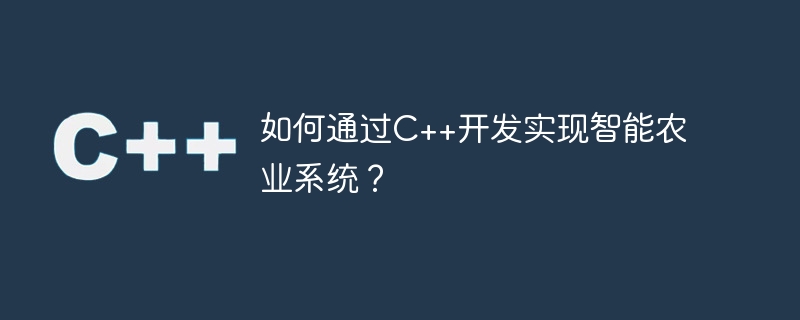

How to implement intelligent agricultural system through C development?
With the continuous development of science and technology, artificial intelligence technology has begun to be applied in various fields, one of which is smart agriculture. By using C development, we can implement an intelligent agricultural system that can greatly improve the efficiency and quality of agricultural production. This article will introduce the steps to develop a C-based smart agricultural system and provide code examples.
Step 1: Define the data structure
Before we start writing code, we need to define the data structure in the system. Smart agricultural systems typically include multiple components such as sensors, actuators, and farm areas. We can use classes in C to define these components.
class Sensor {
// 传感器相关代码
};
class Actuator {
// 执行器相关代码
};
class Field {
// 农田区域相关代码
};Step 2: Implement sensors and actuators
Sensors and actuators are very important components in smart agricultural systems. They can collect and process data from farmland areas and perform corresponding operations. . We can implement them using classes and functions in C.
class Sensor {
public:
void getData() {
// 获取数据的代码
}
};
class Actuator {
public:
void operate() {
// 执行操作的代码
}
};Step 3: Implement the farmland area
The farmland area is the core component of the smart agricultural system, which is responsible for managing and controlling the entire system. We can use C classes and functions to implement the functions of farmland areas.
class Field {
public:
void processData() {
// 处理数据的代码
}
void controlActuator() {
// 控制执行器的代码
}
};Step 4: Write the main program
Before writing the main program, we need to create an intelligent agricultural system object and initialize all components in it. We can then use loops to continuously fetch data, process data, and perform operations.
int main() {
Field field;
Sensor sensor;
Actuator actuator;
while (true) {
sensor.getData();
field.processData();
field.controlActuator();
actuator.operate();
}
return 0;
}Step 5: Test the code
After writing all the code, we can test to ensure the normal operation of the system. We can verify the functionality of the system by simulating sensor data and observing the operation of the actuators.
int main() {
Field field;
Sensor sensor;
Actuator actuator;
// 模拟传感器数据
sensor.getData();
field.processData();
// 控制执行器
field.controlActuator();
actuator.operate();
return 0;
}Through the above steps, we can successfully use C to develop an intelligent agricultural system. By establishing appropriate connections and interactions between sensors, actuators and farm areas, the system can automate the collection, processing and operation of data. This can not only improve the efficiency and quality of agricultural production, but also reduce labor costs and resource waste.
Summary
This article introduces how to use C to develop and implement intelligent agricultural systems. By defining data structures, implementing sensors and actuators, writing farm areas and main programs, and conducting tests, we can successfully create an intelligent agricultural system. This system can automatically collect, process and operate data to improve the efficiency and quality of agricultural production. I hope this article is helpful to you, thank you for reading!
The above is the detailed content of How to implement intelligent agricultural system through C++ development?. For more information, please follow other related articles on the PHP Chinese website!
 What are the differences between c++ and c language
What are the differences between c++ and c language
 Recommended learning order for c++ and python
Recommended learning order for c++ and python
 Cost-effectiveness analysis of learning python and c++
Cost-effectiveness analysis of learning python and c++
 Is c language the same as c++?
Is c language the same as c++?
 Which is better to learn first, c language or c++?
Which is better to learn first, c language or c++?
 The difference and connection between c language and c++
The difference and connection between c language and c++
 C++ software Chinese change tutorial
C++ software Chinese change tutorial
 Cost-effectiveness analysis of learning python, java and c++
Cost-effectiveness analysis of learning python, java and c++




